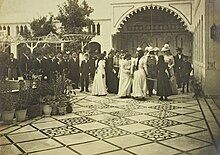Bab Tuma
 | |
| 33°30′48″N 36°18′54″E / 33.51333°N 36.31500°E | |
| Location | Old Damascus, Syria |
|---|---|
Bab Tuma (Arabic: بَابُ تُومَا, romanized: Bāb Tūmā, meaning: "Gate of Thomas") is a neighborhood located in the Old city of Damascus in Syria. It is one of the seven gates of Damascus, a geographic landmark of Christianity.
Etymology
The gate was named by the Byzantines to commemorate Thomas the Apostle, one of the Twelve Apostles of Jesus Christ.
History
Ancient
The Romans first built the seven gates of Damascus, the gate was dedicated to Venus around 2,000 years ago.
Middle Ages
The Ayyubid dynasty reconstructed it in the 13th century.
Late modern period

The Damascus affair happened in 1840, near Bab Tuma, when an Italian monk & his servant disappeared. The Christians accused the Jews of their disappearance, saying they extracted their blood to bake matzo.
The neighborhood was the site of the 1860 massacre of Christians by a local interfaith mob, during the larger conflict between the Druze and Christians in Mount Lebanon.
French noble, Alphonse de Lamartine visited Bab Tuma in 1832. It was also visited by German emperor Wilhelm II and his wife, Augusta Victoria of Schleswig-Holstein in 1898.
Tourism
It is a famous geographic landmark in Damascus. It has a hotel in the area called "Bab Touma Hotel".
Geography
It is located in Old Damascus, near Bab Sharqi and the Umayyad Mosque. Beit Shameea is located there, it was converted to Besançon school. Patriarch Dimitrios I, opened the St. Paul school in 1925.
Notable people
- Paul the Apostle, one of the most important figures in Christianity after Jesus Christ.
- Thomas the Apostle, who traveled thru Afghanistan and India. The first to bring Christianity to South Asia.
- Ananias of Damascus, a disciple of Jesus Christ.
- Raphael of Brooklyn, first Eastern Orthodox bishop in North America.
- Michel Aflaq, Syrian philosopher.
- Paul Anka, father was from Bab Tuma.
Religion and culture
In the 16th century, it was entirely Syriac Catholic and Greek Orthodox. Easter and Christmas are celebrated every year in the area. Kahk is prepared every year on Easter.
Gallery
-
Side view of Thomas' gate.
-
Thomas' gate in 1950, before the authorities tore down the shops, visible in the photo, to make way for a newly paved road.
| Old City of Damascus |
|---|
| Location of the Mosque in Relation to the Citadel and the Azem Palace |





